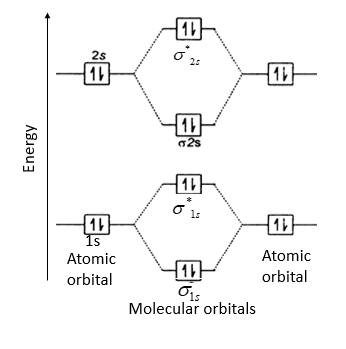Answer
376.2k+ views
Hint: According to the molecular orbital theory, the bond order is defined as the number of covalent bonds in a molecule. Bond order is equal to half of the difference between the number of electrons in bonding (\[{{N}_{b}}\]) and antibonding molecular orbitals (\[{{N}_{a}}\]).
Complete Solution :
\[\text{B}{{\text{e}}_{\text{2}}}\] molecule will be formed by the overlapping of atomic orbitals of two beryllium atoms.
A Be atom has four electrons. It has two valence electrons and its electronic configuration is \[1{{s}^{2}}2{{s}^{2}}\]. Therefore, \[\text{B}{{\text{e}}_{\text{2}}}\] molecule has eight electrons which are to be filled in four molecular orbitals.

Thus, electronic configuration of \[\text{B}{{\text{e}}_{\text{2}}}\] is \[{{\left( \sigma 1s \right)}^{2}}{{\left( {{\sigma }^{*}}1s \right)}^{2}}{{\left( \sigma 2s \right)}^{2}}{{\left( {{\sigma }^{*}}2s \right)}^{2}}\]
Here, bonding electrons, \[{{N}_{b}}\] = 4 and anti-bonding electrons, \[{{N}_{a}}\]= 4
Therefore, bond order (B.O.) of \[\text{B}{{\text{e}}_{\text{2}}}\] molecule is
\[\begin{align}
& \text{B}\text{.O}\text{.=}\frac{1}{2}({{N}_{b}}-{{N}_{a}}) \\
& \text{B}\text{.O}\text{.}=\frac{1}{2}(4-4)=0 \\
\end{align}\]
- Zero value of bond order corresponds to non-existence of \[\text{B}{{\text{e}}_{\text{2}}}\] molecule.
So, the correct answer is “Option D”.
Note: The bond order of a molecule conveys the following information:
1. The stability of a molecule can also be expressed in terms of bond order. Higher the bond order, more stable is the molecule.
2. Bond length: Bond order and bond length are inversely related. Thus, higher the bond order, shorter is the bond length and vice-versa.
3. Bond dissociation energy: Bond order in a molecule is directly proportional to its bond dissociation energy. Greater the bond order, more will be the value of bond dissociation energy.
Complete Solution :
\[\text{B}{{\text{e}}_{\text{2}}}\] molecule will be formed by the overlapping of atomic orbitals of two beryllium atoms.
A Be atom has four electrons. It has two valence electrons and its electronic configuration is \[1{{s}^{2}}2{{s}^{2}}\]. Therefore, \[\text{B}{{\text{e}}_{\text{2}}}\] molecule has eight electrons which are to be filled in four molecular orbitals.

Thus, electronic configuration of \[\text{B}{{\text{e}}_{\text{2}}}\] is \[{{\left( \sigma 1s \right)}^{2}}{{\left( {{\sigma }^{*}}1s \right)}^{2}}{{\left( \sigma 2s \right)}^{2}}{{\left( {{\sigma }^{*}}2s \right)}^{2}}\]
Here, bonding electrons, \[{{N}_{b}}\] = 4 and anti-bonding electrons, \[{{N}_{a}}\]= 4
Therefore, bond order (B.O.) of \[\text{B}{{\text{e}}_{\text{2}}}\] molecule is
\[\begin{align}
& \text{B}\text{.O}\text{.=}\frac{1}{2}({{N}_{b}}-{{N}_{a}}) \\
& \text{B}\text{.O}\text{.}=\frac{1}{2}(4-4)=0 \\
\end{align}\]
- Zero value of bond order corresponds to non-existence of \[\text{B}{{\text{e}}_{\text{2}}}\] molecule.
So, the correct answer is “Option D”.
Note: The bond order of a molecule conveys the following information:
1. The stability of a molecule can also be expressed in terms of bond order. Higher the bond order, more stable is the molecule.
2. Bond length: Bond order and bond length are inversely related. Thus, higher the bond order, shorter is the bond length and vice-versa.
3. Bond dissociation energy: Bond order in a molecule is directly proportional to its bond dissociation energy. Greater the bond order, more will be the value of bond dissociation energy.
Recently Updated Pages
Basicity of sulphurous acid and sulphuric acid are

Three beakers labelled as A B and C each containing 25 mL of water were taken A small amount of NaOH anhydrous CuSO4 and NaCl were added to the beakers A B and C respectively It was observed that there was an increase in the temperature of the solutions contained in beakers A and B whereas in case of beaker C the temperature of the solution falls Which one of the following statements isarecorrect i In beakers A and B exothermic process has occurred ii In beakers A and B endothermic process has occurred iii In beaker C exothermic process has occurred iv In beaker C endothermic process has occurred

What is the stopping potential when the metal with class 12 physics JEE_Main

The momentum of a photon is 2 times 10 16gm cmsec Its class 12 physics JEE_Main

How do you arrange NH4 + BF3 H2O C2H2 in increasing class 11 chemistry CBSE

Is H mCT and q mCT the same thing If so which is more class 11 chemistry CBSE

Trending doubts
Difference Between Plant Cell and Animal Cell

Difference between Prokaryotic cell and Eukaryotic class 11 biology CBSE

Fill the blanks with the suitable prepositions 1 The class 9 english CBSE

Fill the blanks with proper collective nouns 1 A of class 10 english CBSE

Change the following sentences into negative and interrogative class 10 english CBSE

Select the word that is correctly spelled a Twelveth class 10 english CBSE

What organs are located on the left side of your body class 11 biology CBSE

What is the z value for a 90 95 and 99 percent confidence class 11 maths CBSE

Give 10 examples for herbs , shrubs , climbers , creepers



